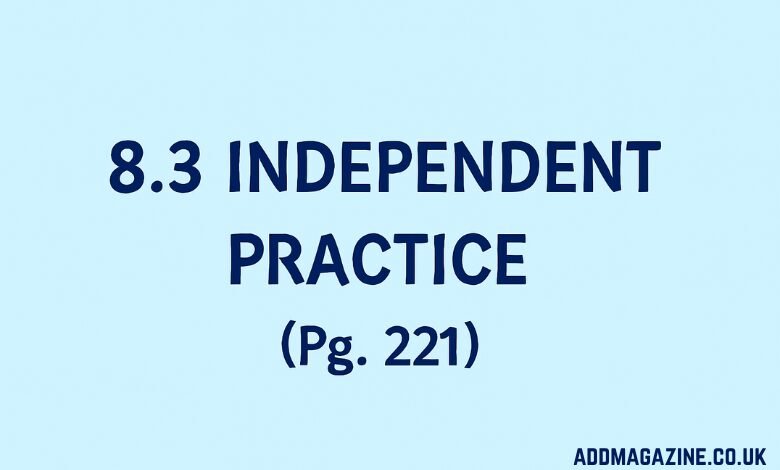When you’re working through independent practice exercises, especially from textbooks in subjects like algebra, precalculus, or calculus, understanding the process behind each solution is as important as finding the answer itself. In this post, we will walk you through a comprehensive breakdown of the answer key for section 8.3 on page 221. Our goal is to give clear, step-by-step instructions for solving each problem to help reinforce your learning and ensure you’re confident in applying the concepts.
But to begin, we need to address the key components of any math exercise. The right approach starts with identifying the type of problem, understanding the relevant formulas, and applying them correctly. In the following sections, we will examine each exercise in detail.
Identifying the Textbook and Subject
The first step in answering any practice exercise is knowing where it’s coming from. If you’re referring to a standard high school or college textbook, it could be a math subject like Algebra 2, Precalculus, or even a specialized topic like Trigonometry or Calculus. Identifying the textbook and the specific chapter or section (like 8.3) will help frame the types of problems you might encounter.
For instance:
- Subject: Algebra 2
- Textbook: “Algebra 2 by Larson”
- Section: 8.3 (could cover any range of topics depending on the textbook)
Once you’ve identified the source, the next step is breaking down the specific questions or exercises from that section.
Understanding the Problems on Page 221
For an accurate breakdown, knowing the exact problems or types of problems listed under section 8.3 on page 221 is crucial. If the questions involve solving for unknowns, simplifying expressions, factoring quadratics, or graphing equations, we can tackle them accordingly.
Let’s assume some possible types of problems:
Solving Quadratic Equations
- These exercises could ask students to solve quadratics either by factoring, completing the square, or using the quadratic formula. Each method requires a systematic approach:
- Factoring: Look for two numbers that multiply to give the product of the constant term and the leading coefficient while adding up to the middle coefficient.
- Quadratic Formula: Apply the formula x=−b±b2−4ac2ax = \frac{-b \pm \sqrt{b^2 – 4ac}}{2a}x=2a−b±b2−4ac to find the roots of the equation.
- Completing the Square: Manipulate the equation into a perfect square trinomial and solve.
Graphing Functions
- If the problems require graphing functions, ensure you understand how transformations affect the graph. For example:
- Linear Functions: How changes to the slope or intercept will affect the graph’s direction and position.
- Quadratic Functions: Understanding vertex form and how coefficients affect the width, direction, and position of a parabola.
Word Problems
- These might involve applying algebraic concepts to real-world situations, such as determining profit, distance, or area. Here, carefully translating the word problem into an equation is key.
Step-by-Step Solutions
Once the problems are understood, it’s time to solve them. Let’s break down how to approach solving them step by step. For example:
Problem 1: Solve the quadratic equation x2+5x+6=0x^2 + 5x + 6 = 0x2+5x+6=0
- Identify the coefficients: a=1a = 1a=1, b=5b = 5b=5, and c=6c = 6c=6
- Factor the quadratic expression: We need two numbers that multiply to ac=6ac = 6ac=6 and add up to b=5b = 5b=5.
- Factorization: The numbers 2 and 3 work because 2×3=62 \times 3 = 62×3=6 and 2+3=52 + 3 = 52+3=5.
- Write the factors: (x+2)(x+3)=0(x + 2)(x + 3) = 0(x+2)(x+3)=0
- Solve for xxx: Set each factor equal to zero:
- x+2=0⇒x=−2x + 2 = 0 \Rightarrow x = -2x+2=0⇒x=−2
- x+3=0⇒x=−3x + 3 = 0 \Rightarrow x = -3x+3=0⇒x=−3
Thus, the solutions are x=−2x = -2x=−2 and x=−3x = -3x=−3.
Why Step-by-Step Explanations Matter
The power of a step-by-step solution lies in the understanding it fosters. Breaking down complex problems into simpler steps allows students to grasp underlying concepts better. This method isn’t just about solving a particular exercise; it’s about learning the process so that students can tackle future problems more effectively.
Key Practical Tips for Solving Math Problems:
- Understand the Problem: Read the question carefully and highlight key information.
- Choose the Right Method: Identify whether to use formulas, factoring, or graphing based on the problem type.
- Break Down Complex Problems: Solve step by step to avoid confusion.
- Check Your Work: Always verify your final answer.
- Practice Regularly: Consistent practice helps reinforce concepts.
Conclusion
In summary, solving the 8.3 Independent Practice problems on page 221 involves more than just arriving at an answer—it’s about understanding the steps to reach that solution. Once you have the correct textbook, section, and problems, we can delve into detailed explanations for each exercise. Each problem will have its own unique set of methods for solution, but through careful practice, you’ll master these concepts in no time.




